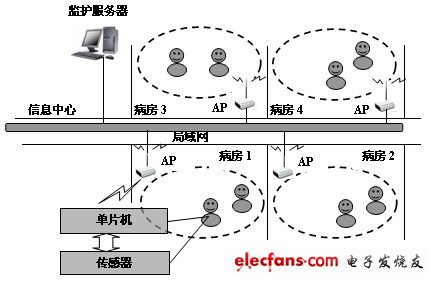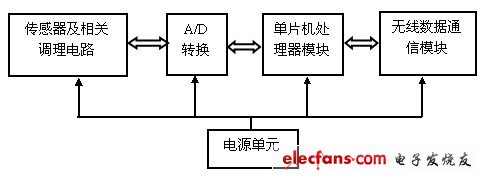With the rapid development of electronic information, in recent years, telemedicine monitoring technology has gradually become a hot spot in the medical field. The remote monitoring of important vital parameters has brought convenience to the elderly and the infirm, and has also contributed greatly to the development of the modern medical community.
Telemedicine monitoring system, a high-tech industrial product integrating information science, computer technology and communication application technology in the field of health care. The main components of the system are: based on the micro-controller and sensor node composition sign acquisition module, based on GPRS/GSM wireless transceiver module, FPGA-based PC monitoring module. The sign collection module uses various special sensors to collect human body signs, which are processed and packaged by the microcontroller, and uploaded to the upper computer monitoring center via the GPRS/GSM communication network. The remote doctor/guardian can monitor the patient regularly/in real time. The system has accurate measurement, practical and innovative, high cost performance, and has good promotion value.
Second, the design requirements
Design a telemedicine monitoring system. Claim:
1. Accurately collect various vital signs through each sensor node and submit them to 89c51 MCU for processing, calculate various vital signs information (including body temperature, blood pressure, pulse, heart rate), form a physical sign collection sub-module, and complete the collection of various physical signs information. And upload to the GPRS/GSM wireless module.
2. The GPRS/GSM wireless module will receive the physical sign information and send it to the upper monitoring machine accurately.
3. The upper monitoring machine based on FPGA receives the information of the lower computer, and performs analysis processing and control.
Third, design equipment
1. Various types of physical sensors (ASDX100 pressure sensor, HK-2000B pulse sensor, DS18B20 temperature sensor);
2. Microcontroller, GPRS/GSM module, FPGA development box;
3. A number of solders, such as tweezers, pliers, resistor and capacitor potentiometer wires.
Fourth, the design principle and design
Design principle
The remote monitoring system can be defined as a technical means for transmitting remote physical signs and medical signals to the upper computer monitoring center through wireless communication technology for analysis and giving a diagnosis opinion.
(1) Principles of medical monitoring
Remote monitoring of important vital parameters is an important part of the oral monitoring of the elderly and infirm. The physiological information detected includes: body temperature, pulse, blood pressure, heart rate, electrocardiogram, respiration, blood gas (oxygen partial pressure and carbon dioxide partial pressure), blood. Oxygen saturation, blood sugar, etc. Such physiological parameters generally require non-invasive or minimally invasive detection in remote monitoring systems. In this paper, temperature, pulse, blood pressure and heart rate signals are collected, and simple and convenient sensors and non-invasive measurement methods are selected.
(2) Wireless communication technology
With the continuous development of information technology and the growth of the demand for social demand, wireless communication has entered the stage of large-scale development. The rapid development of wireless communication has become the most dazzling "bright spot" in the information industry, providing various potential engineering technologies. New methods and means have become a powerful driving force for social development. Wireless communication shows a broad market prospect because it does not need to be equipped with bright lines and convenient use. Wireless communication technology is entering many products at a relatively fast speed. Compared with wired, it has the advantages of low cost, convenient carrying and troubles of wiring, especially suitable for remote control, telemetry, wireless meter reading, access control system, and community paging. , industrial data acquisition system, wireless tag, identification, contactless RF smart film, small wireless data terminal, security fire protection system, wireless remote control system, biosignal acquisition, hydrometeorological monitoring, machine control, information appliances, wireless 232, wireless 422 /485 Data communication and other fields.
Using GPRS/GSM technology for wireless communication, the traditional serial communication is extended to GPRS/GSM wireless network communication, and the collected data can be sent to the upper computer in real time, realizing timely data exchange and fast wireless networking of serial devices.
2. Design plan
(1) Hospital monitoring network system plan
The hospital monitoring system consists of a wired network (local area network) and a wireless network, as shown in Figure 4.1. The collection terminal worn by the patient sends the collected physiological information data (body temperature, pulse, blood pressure, heart rate) to the AP (Access Point). The AP forwards the data to the upper monitoring machine through the hospital's local area network, and the upper monitoring machine analyzes and processes the data.
After the AP is powered on, try to connect to the server on the LAN. The IP address and port number of the server and the network configuration of the AP are written in the configuration file. The user can manually modify it and enter the ready state after the connection is successful.
If a patient carrying a mobile monitoring device enters the coverage area of ​​the AP, the mobile monitoring device will query the AP and establish an ACL link with it. The AP accepts the connection and will perform master-slave switching, ensuring that the AP as the main unit of the sensor network can continue to be Other mobile monitoring devices are discovered and built. Then, the SDP, L2CAP, and RFCOMM connections are made between the mobile monitoring device and the AP. The AP reports to the server that the mobile monitoring device has entered the area, after which the AP will transparently forward the two-way data between the AP and the mobile monitoring device. The host can complete the functions of control and data acquisition through the serial port replacement function of the AP and the mobile monitoring device. When the patient leaves the coverage of the AP, the link is broken, and the AP reports to the server that the mobile monitoring device leaves the area, and the mobile monitoring device carried by the patient starts searching for a new AP. According to which AP is connected to the mobile monitoring device, the medical staff can know the patient's activity in the entire ward. Its design structure is shown in Figure 1.

Figure 1 Hospital wireless monitoring system structure
(2) Family monitoring network system plan
The remote home monitoring network architecture is shown in Figure 2.

Figure 2 Home wireless monitoring system structure
The wireless system mainly consists of various sensor nodes (sensor nodes such as pulse, body temperature, blood pressure, heart rate, etc.), several wireless nodes with routing functions, and a central network coordinator (monitoring base station device). The monitoring base station device is connected to the wireless network and the Ethernet, and is a core part of the home wireless network, and is responsible for the management of the sensor network node and the device node. The vital signs data are transmitted to the remote monitoring server through the home gateway. The remote monitoring server is responsible for the real-time collection, display and storage of pulse physiological data. The hospital monitoring center and doctors can log in to the monitoring server to view the physiological information of the ward, or remotely control the sensors and devices in the home wireless network, so that when the patient being monitored is abnormal, it can detect and take rescue measures in time. Relatives of the ward, etc. can also log in to the monitoring server to keep track of the health status of the ward.
Fifth, the design process
1. Sensor unit design
The main function of the sensor node is to collect body sign information (including body temperature, pulse, blood pressure, heart rate). Its nodes mainly include 5 parts: central processor module (51 MCU), wireless data communication module (GPRS/GSM), sensor, A/ D conversion and related conditioning circuits, power modules. The block diagram and processor unit are shown in Figure 3.

Figure 3 Monitoring sensor node structure
2. Design of GPRS/GSM module
This paper introduces a remote monitoring of the data acquisition system on the project through the transmission and reception of GPRS/GSM short messages, which can complete the monitoring of the running status of the data acquisition system and the transmission of the collected data. At the same time, the specified operation can be completed by the short message control data acquisition system. The system comes with a memory that can configure the device according to the received instructions and store it in the device's own memory. At the same time, the system is equipped with a watchdog, which enables the system to restart the system in an abnormal state, so that the system will never crash. Because the system adopts GSM short message as the communication carrier, it overcomes the disadvantages of unfriendly human-machine interface, high telephone bills, and few control functions. The GSM hardware diagram is shown in Figure 4 below.
More design details and source code: [ see details ]
Low Rate Nicd Battery KPL Series
Established in 1956, during the China first five-year-plan, Henan Xintaihang Power Source Co., Ltd. (Factory No.755) was the first R&D and manufacturing enterprise in China in the field of alkaline storage batteries and modular power system and it was also the military factory which owned the most varieties rechargeable batteries in domestic. Taihang was located in national Chemistry and Physicals Power Source Industrial Park, Xinxiang City, Henan, China.
Low Dishcharge Rate Nickel Cadmium Battery, KPL10~KPL1200, Max. discharge current <0.5C.
The nickel–cadmium battery (NiCd battery or NiCad battery) is a type of rechargeable battery using nickel oxide hydroxide and metallic cadmium as electrodes. The abbreviation NiCd is derived from the chemical symbols of nickel (Ni) and cadmium (Cd).
Ni Cd Battery,110V Kpl 300Ah Battery,Kpl1000Ah Nicd Battery,Low Rate Nicd Battery Kpl Series
Henan Xintaihang Power Source Co.,Ltd , https://www.taihangbattery.com